Toshiba 55UK4D63DB Review
Has Toshiba's budget telly got what it takes to be the budget TV champ?
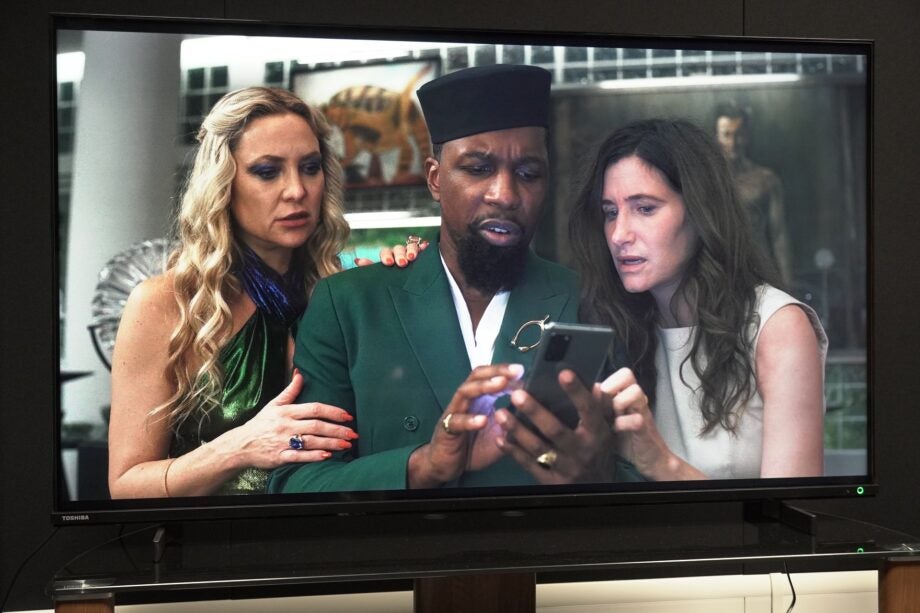
Verdict
A decent performer for the asking price with a better-looking design and decent picture quality, but the smarts and feature set is falling behind Toshiba’s rivals and the audio system is a misfire. It feels like Toshiba’s non-Fire/Android TV models are standing still, while others are moving forwards.
Pros
- Good SDR picture
- Excellent Alexa integration
- Easy to use interface
- Quick gaming input
Cons
- Middling sound
- Missing some big SVOD apps
- Limited brightness with HDR
Availability
- UKRRP: £349
- USAunavailable
- Europeunavailable
- Canadaunavailable
- Australiaunavailable
Key Features
- Frameless designFor a sleek appearance
- Tru Picture EngineIncludes TRU Resolution, TRU Micro Dimming and TRU Flow MEMC
- HDR supportDolby Vision, HDR10 and HLG compatible
- Built-in AlexaFor voice assistance and smart home control
Introduction
As the big brands appear to be shying away from the budget reaches of the TV market, it’s left the likes of Toshiba with its UK4D model in prime position to sweep up.
The affordable side of the market is one Toshiba has courted since it returned a few years back, producing a steady flow of budget TVs that put in a good picture performance and built-in smarts in the form of Alexa.
But with Fire TV launching in more and more models and Roku flooding the market with new TVs, Toshiba won’t have an easy time securing your hard-earned cash.
Design
- Reflective screen
- Quick to assemble
- Better aesthetics than previous Toshiba TVs
I’ve moaned about the design of Toshiba’s previous TVs. The last few generations have felt as if they re-used the chassis from before or just exuded plastic.
Function over form is less of an issue at the cheaper end of the market, but at least the UK4D tries in aesthetic terms.
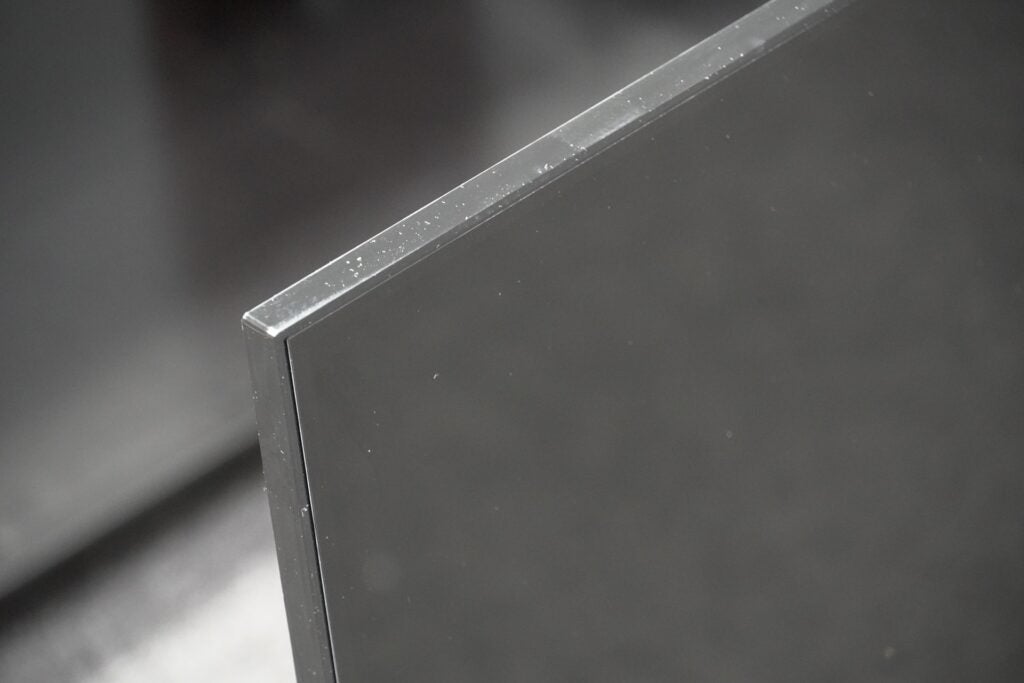
It’s still black and predominantly plastic, but it feels and looks of a higher quality than before. Assembling the TV took me less than three minutes as all you need to do is screw in the feet provided to literally “get it on its feet”. The feet are on either side of the TV, so if you have small furniture, you’ll need to take that into account.
The feet don’t elevate the TV as high as I expected, as the low-slung nature of the TV’s chassis doesn’t provide room to add a soundbar without blocking some of the screen.
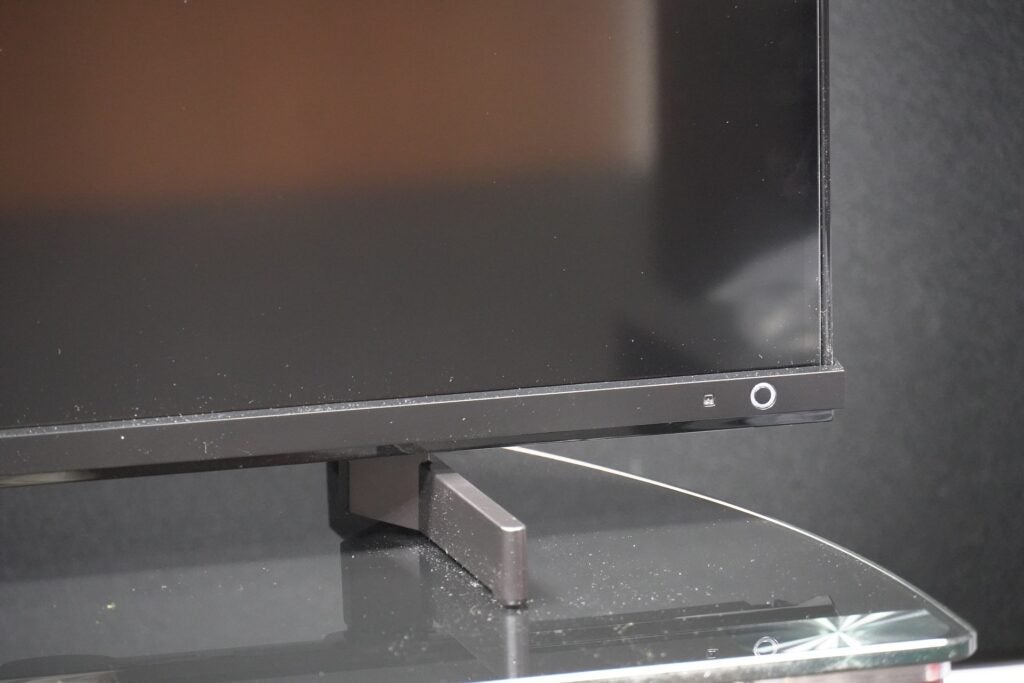
Finally, the screen is one I found very reflective in a bright room. There isn’t any absorption of ambient light so everything is reflected onto the screen, which becomes very noticeable when watching content that’s dark. Viewing angles are also best head on, as moving to the side can lead to a reduction of colours and contrast.
Interface
- Linux interface
- Missing Disney and Apple apps
- Easy to use
For Toshiba’s home-grown TVs they’re using homebrew software in Linux OS. Some of their other TVs have moved to Android or Fire TV, and it does feel as if Toshiba’s own models have been left behind in terms of apps and features.
The Toshiba/Linux combination is still a relatively easy and neat one to use. It’s not full screen, as calling it brings up a row at the bottom of the screen to scroll through Settings, Sources, Apps, and other options. There is still that bug (or at least I was told it was one) whereby pressing the Home button in an app opens the Settings page and not the app bar.
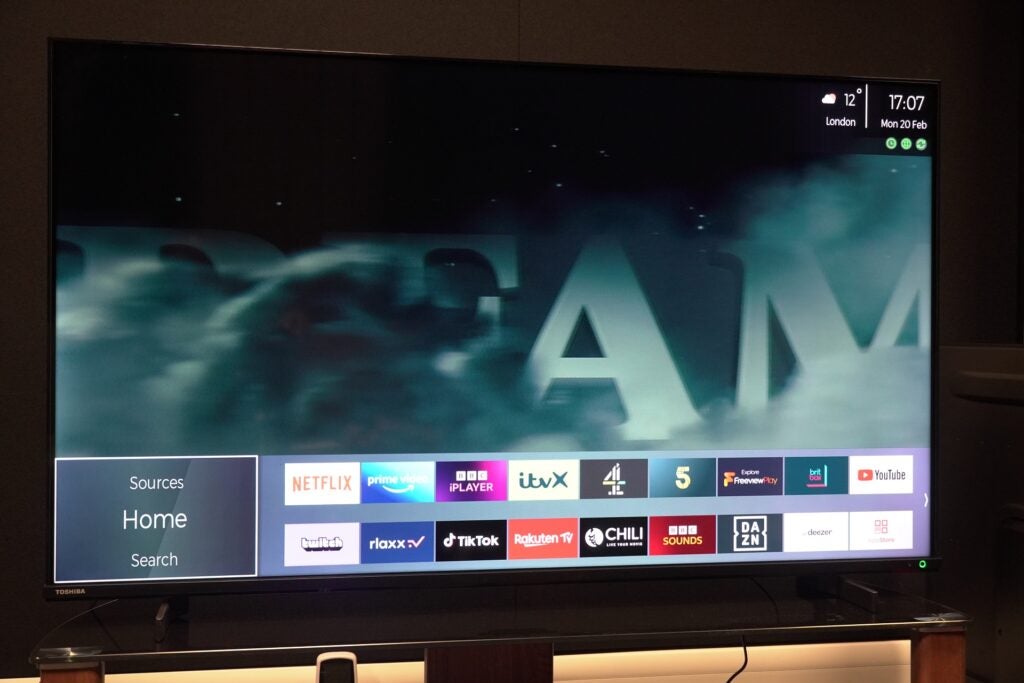
The remote remains the same large wand Toshiba has used with its TVs for several years, and I do wish they’d level it up as it looks a little cheap and dated.
I’ve got no problems with how it feels to use, the buttons are well-spaced out and there’s decent feedback with presses. There are shortcuts stationed at the bottom that include Freeview Play, Prime Video, Netflix, and Twitch, if you’re into your gaming streams.
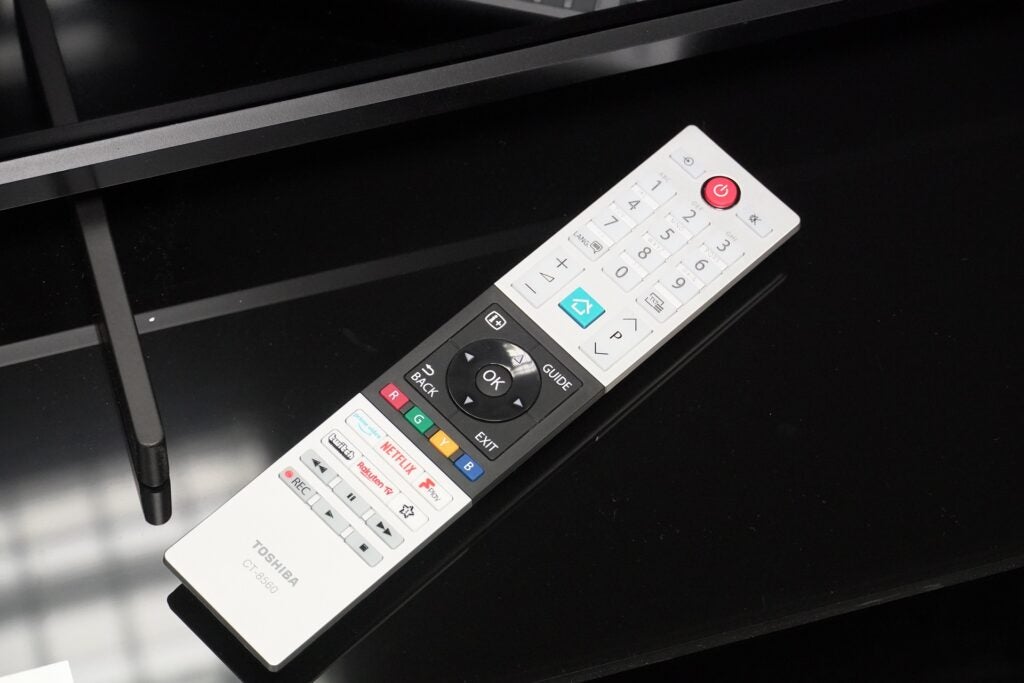
The app selection is nowhere near as big as what you’d find on Toshiba’s Fire TV or Android models, missing big hitters in Disney+ and Apple TV+. If you subscribe to those apps, you’d need a streaming stick, but I wouldn’t advise a Fire TV Stick as that would just double up on the Alexa support.
Features
- Built-in Alexa integration
- Three HDMI 2.0 inputs
- Fast gaming performance
Alexa comes built in, so you won’t even need the remote for access. Like the UK31 model I tested in 2022, you must log in otherwise you’ll be bugged by a notification every time the TV is turned on. If you’re an Alexa user it makes sense, but if you’re not, a rival one that doesn’t have it may hold more appeal…
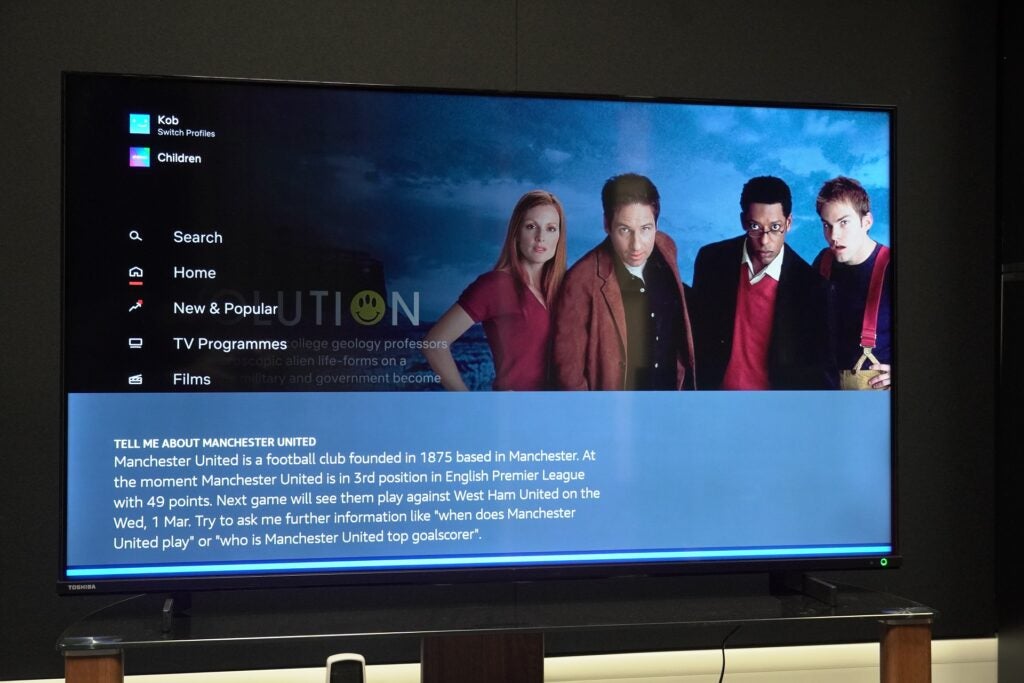
In practice, the integration of Alexa is excellent. She understood my queries and acted upon them quickly, whether it was asking about the weather or switching inputs. The only problem I did have was that Alexa wasn’t able to call up any of the Freeview Play apps or Freeview Explore, which seemed an odd restriction.
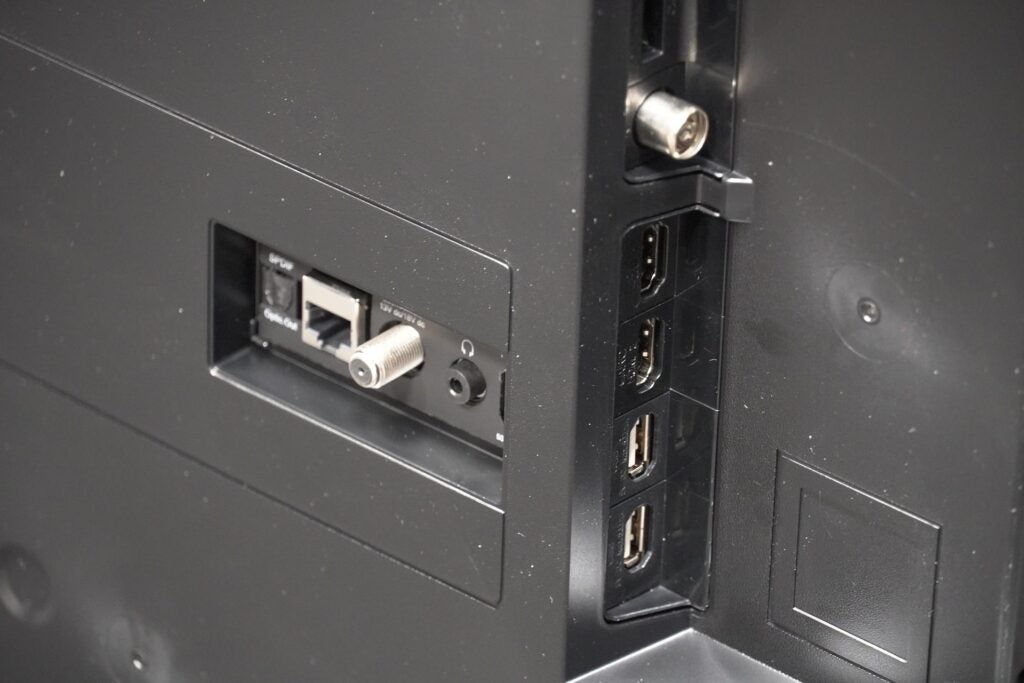
Connections are limited to three HDMI 2.0 inputs, two USB, Ethernet, digital audio output, headphone out and an aerial input for live TV. There is Wi-Fi as well as Bluetooth for streaming, and you can mirror a mobile screen to the TV.
There is no eARC to pass through high-quality audio formats such as Dolby Atmos to a soundbar, but there is auto low latency mode (ALLM) to put the TV into its most receptive state for gaming.
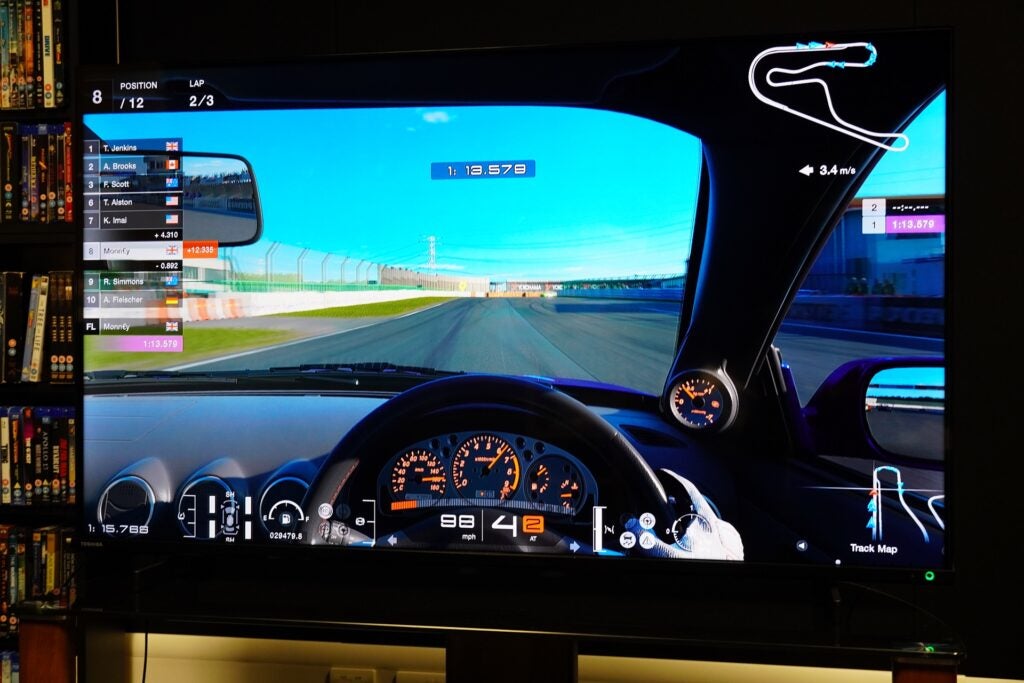
I measured latency at 10.7ms, which is speedy and certainly a big improvement on the Sharp EQ3A’s 50ms. However, while latency is fast, the colour temperature of the game mode skews to blue, and image quality is a little blurry when handling motion in Gran Turismo 7. A change to the ‘low’ motion setting results in fewer issues but it still looks odd.
Picture Quality
- Limited brightness with HDR
- Good SDR colours
- Mixed upscaling performance
The Toshiba UK4D won’t shatter any notions of performance in the budget TV market. I measured its HDR performance at 329 nits on 5 and 10% windows in its Natural (i.e., standard) picture mode, which was its highest peak brightness. Curiously, not even its Dynamic mode went brighter.
That level of brightness isn’t enough to make a difference and it shows. Take Death on the Nile in HDR10 on 4K Blu-ray, a rich and opulent looking film on the right screen, but on the UK4D colours just lack that bit of vim and vigour, such as the red dress Emma Mackey’s character wears near the film’s start. The lack of Wide Colour Gamut (WCG) would explain this as it affects the range of colours the Toshiba can portray.
Black levels are portrayed solidly enough, but contrast is lacking without the brightness to assist, giving the scene a flat appearance. Shadow detail is lacking too, the detail on Poirot’s jacket makes it look all black when the jacket is actually two-toned. The Dolby Vision version on Disney+ makes a better fist of the balance between shade and light, deepening the contrast and giving the highlights more luminosity.
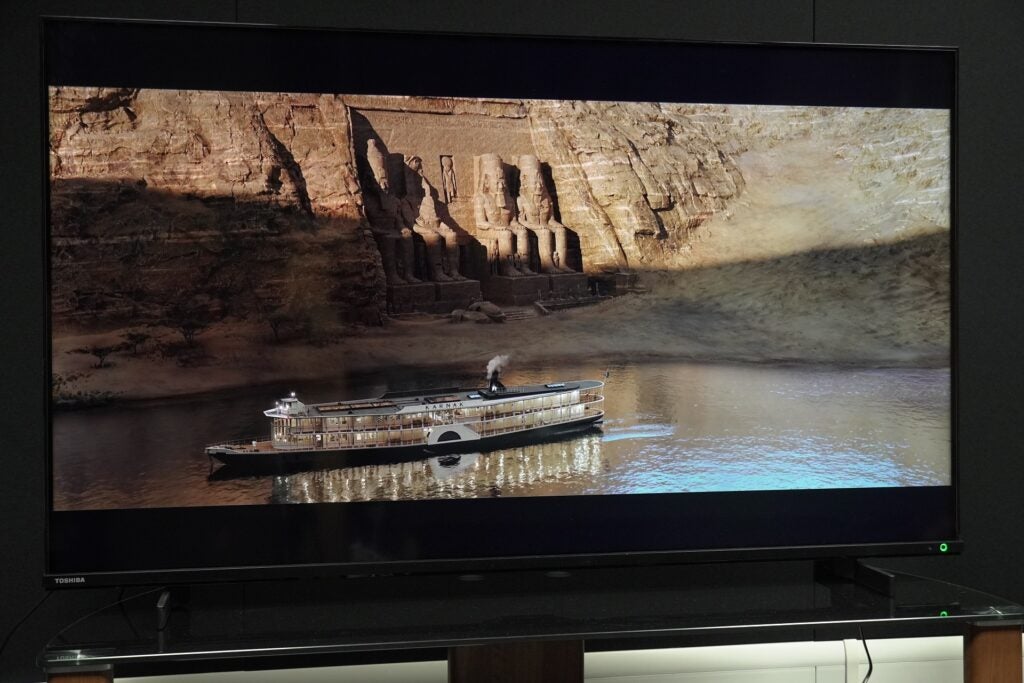
Jump to the Egypt-based part of the film and despite the orange tones and sun-dappled scenes, this part of the film doesn’t look all that bright; the orange tones lack the vibrancy to make the image stand out. But in terms of overall clarity and detail, it’s solid.
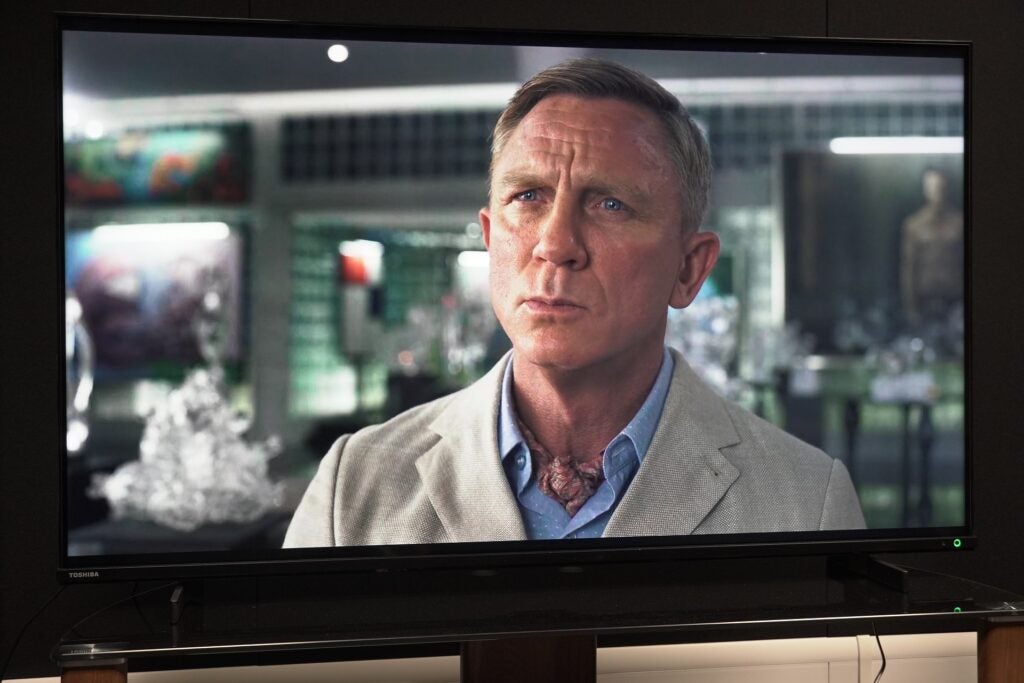
The same is true of Glass Onion on Netflix. The detail and textures of Mile’s statues in his Greek hideaway are satisfactorily conveyed, and though the UK4D isn’t the sharpest looking image, the tailoring on show is all well revealed, bringing out the finer detail of Benoit Blanc’s suits to a tee.
With scenes that are darker or set at night time the Toshiba’s picture can look a little washed out, as blacks lose an aspect of depth and strength.
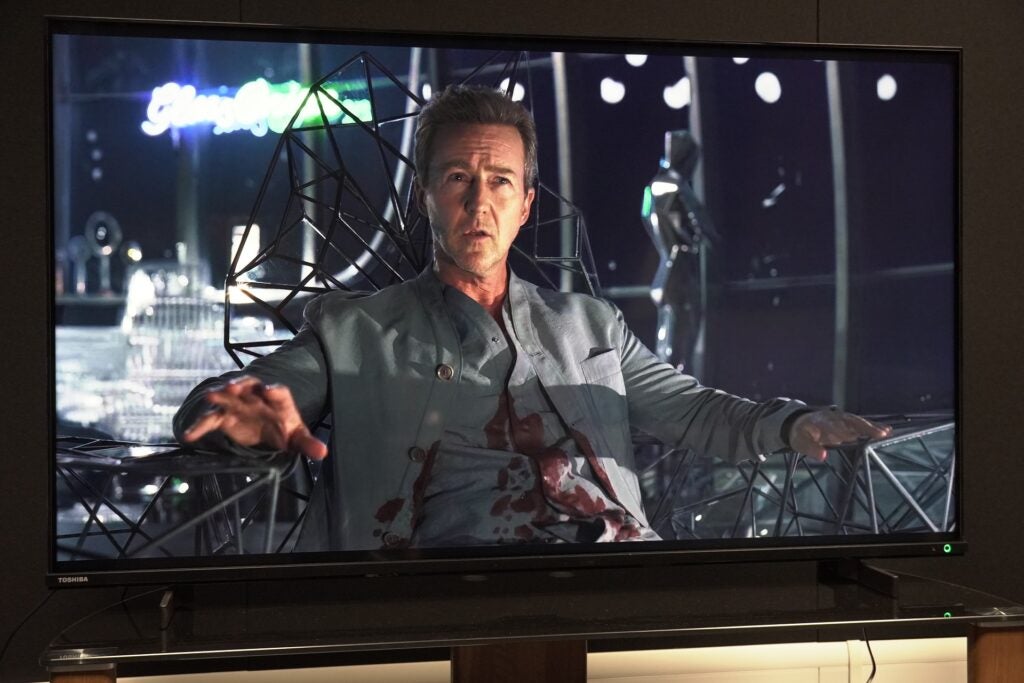
The 55UK4D63DB is a solid performer with the complexions of the Glass Onion cast, who look natural enough, though there was a little discolouration – a green tinge in their faces I also noticed with the UK31. It’s not as bad as it was there, but still visible in moments.
With SDR colours the Toshiba is on more solid ground. With a Blu-ray of The Force Awakens, the orange tones of the lettering in the opening crawl stand out better against the blackness, as do the stars in space as the stormtroopers descend to the planet. The orange sands of Jedda and the blue hues of smoke and lights give that scene colours that have depth and solidity.
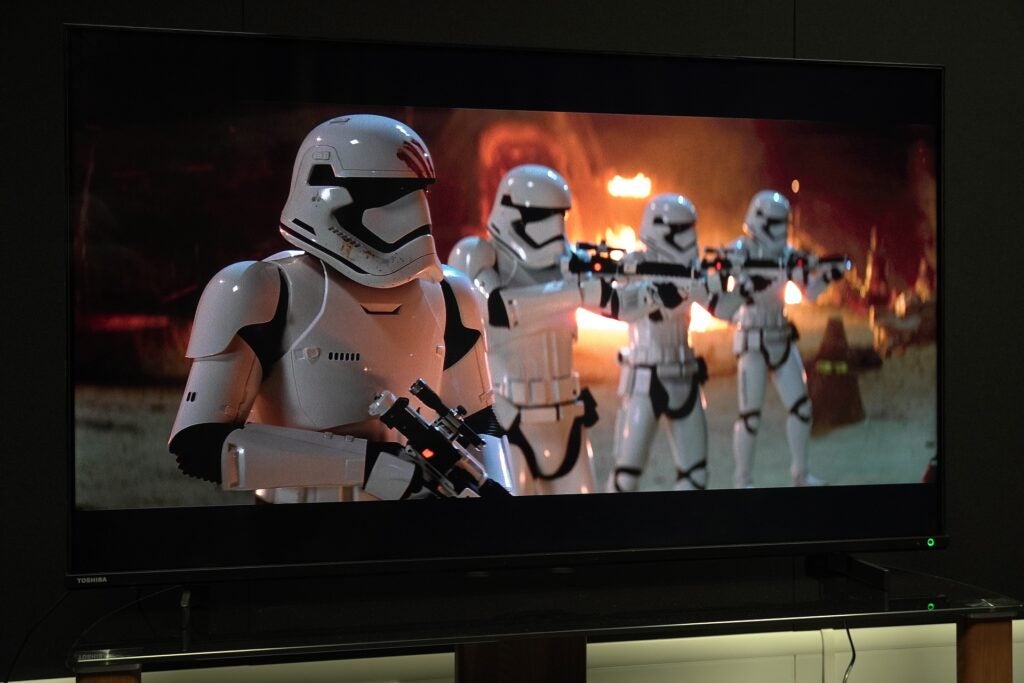
The set’s motion processing, known as Tru Flow, can look unreal at its medium setting but not too artificial. There’s no noticeable noise or pixelation with the swift camera pans as the stormtroopers land, though I did spy some ghosting as Poe Dameron runs back to his ship.
Like many affordable TVs, the Toshiba 55UK4D63DB can struggle when upscaling lower-resolution content. DVDs of Unbreakable and Mulholland Drive exhibit softness, noise and a lack of clarity and detail. With the former DVD, the Toshiba particularly struggled, as some scenes descended into a smudgy mess, with edges that were soft and blurriness with movement even when the Tru Flow processing was turned off.
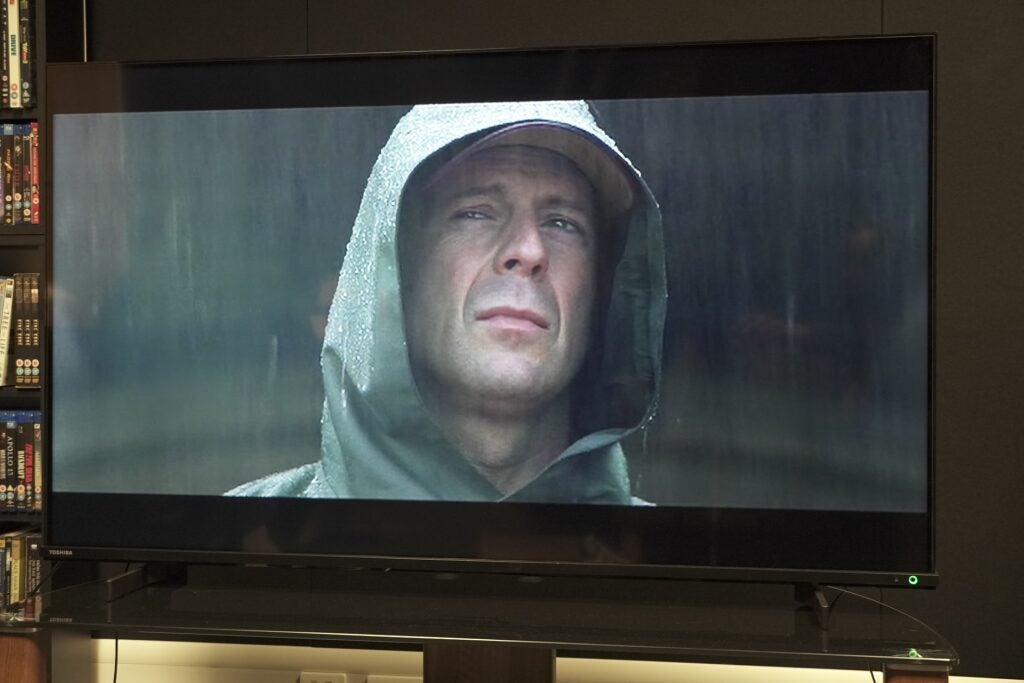
Mulholland Drive fared a little better, partly because the film’s photography takes on a soft, dreamy look; but it was still lacking in definition and a deficit of detail in some scenes. Playing around with Noise Reduction settings didn’t bring about any benefits either. But even in light of the various problems I’ve highlighted, the colour performance is natural, especially in Cinema mode.
Sound Quality
- Flat, lacking dynamics
- Good vocal clarity
The Toshiba 55UK4D63DB’s audio system isn’t going to pull up any trees. The 20W down-firing system is made by Onkyo who’ve done a good job in other budget TVs, but this is a feeble, flat performance.
There’s support for Dolby Atmos but you wouldn’t really know it. Watching Netflix’s Wednesday in Atmos and the performance is hemmed in and lacks clarity when dealing with the boat race sequence. It sounded muddled at best.
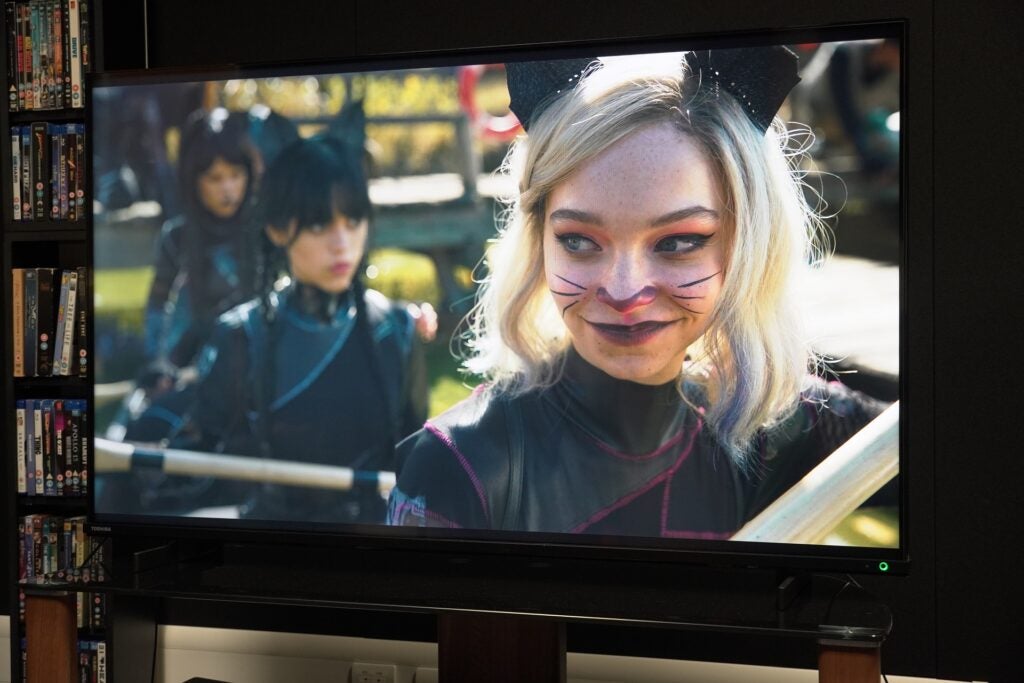
Glass Onion and Death on the Nile sound better, clearer, and more detailed but dynamism was lacking. Bass is punchy but I’m not talking huge amounts. Dialogue was clear and prioritised, but the soundstage is flatly conceived with no depth.
When the action kicks off in The Force Awakens on Jedda as Rey and Finn are chased by stormtroopers it all sounds… unexciting. John Williams’ excellent score is presented with a degree of dynamism but even that feels half-hearted. There’s no doubting a soundbar is needed to liven things up, but you’ll have a bit of trouble fitting it below the screen.
Latest deals
Should you buy it?
If you’re an Amazon Alexa user: Alexa is built into this unit so if you are looking for an affordable smart TV with Alexa tricks, this is a contender.
There are other sets with better value: This Toshiba model is falling behind sets from Roku and Amazon for features. Even Toshiba’s own Fire and Android TV models are a better bet in terms of value.
Final Thoughts
The Toshiba 55UK4D63DB is a solid TV, but the issues that it has – with ageing features compared to Fire and Android TVs – are nothing new and feel as if they haven’t been rectified.
This is fine enough for the asking price but the market has become very competitive, and Toshiba’s homegrown TVs are becoming at risk of being left behind in the wake of their rivals.
How we test
We test every television we review thoroughly over an extended period of time. We use industry standard tests to compare features properly. We’ll always tell you what we find. We never, ever, accept money to review a product.
Find out more about how we test in our ethics policy.
Tested for a month
Tested with real world use
Benchmarked with tests
FAQs
Yes, the ITVX app is supported on the Toshiba UK4D TV through Freeview Play.
Full specs
Sustainability
Trusted Reviews’ holds the fact that global warming is not a myth as a core value and will continuously endeavour to help protect our planet from harm in its business practices.
As part of this mission, whenever we review a product we send the company a series of questions to help us gauge and make transparent the impact the device has on the environment.
We currently haven’t received answers to the questions on this product, but will update this page the moment we do. You can see a detailed breakdown of the questions we ask and why in our sustainability info page.








